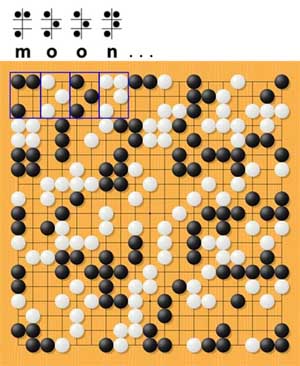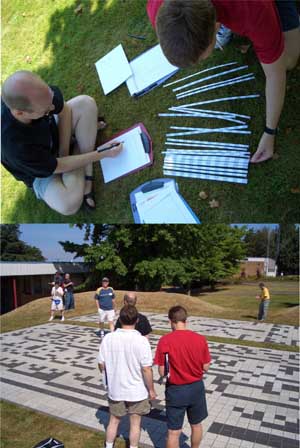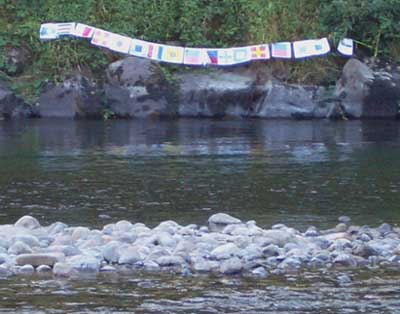The Game Is Afoot
Thirty-two hours in a van, scavenging for clues and solving puzzles--that's "the Game," a battle of smarts and endurance, and the competition is beyond fierce. Part two: Cracking codes and scaring the locals.
“Whoa! Guys, come look at this!”
We gather around.
“Have you ever seen anything like this before?”
“Sure, lots of them have stickers.”
“Yeah, but have you ever seen this sticker before? I haven’t. And, look: it’s totally different than the stickers on the others.”
“What does it say on it? The words are all smudged.”
“I can’t make it out. But we should probably hang on to it.”
It’s 7:15 on the morning of the Game, and we are agonizing over a banana.
One hallmark of the Game is that you can never really be sure when the Game starts. Game Control—the group of people who run any given Game, colloquially known as “GC”—gives you an official start time, sure. But as the “pre-clues” attest, you’re pretty much playing the Game from the moment your application is accepted.
A few Games back, GC gave an elaborate multimedia presentation to the players on the evening before the Game began. Teams that failed to find and solve the puzzle hidden in the spiel were caught unawares the following morning when GC came bursting into their hotel rooms an hour before the stated start time and announced that the Game had already begun.
So the crew of the “B” Ark had assembled in the captain’s quarters well before breakfast was due to arrive, just in case. Fortunately, it looks like the given start time is on the up-and-up on this occasion. Even so we can’t help but be paranoid that we’re missing something critical, so we scrutinize everything we’ve been given, even down to the stickers on the bananas.
We eventually decide that the mystery sticker is, in fact, just a sticker. Pat carries it over to the trashcan to throw it out, but then, at the last moment, opts to set it on the dresser instead. We dump out the Raisin Bran, looking for any hidden “prizes”; afterwards we tear open the box to ensure that there are no secret messages written on the inside.
With our breakfast came a copy of Galaxy Today, a colorful faux-newspaper that features pictures of the Galactic Consortium and a headline reading “B Arks Recalled After Donut Dispenser Malfunction.” On the back there is a crossword puzzle. It is a relief to find a puzzle that actually looks like a puzzle.
We dig around in the grocery bag a bit more, and finally find it. There, at the bottom, is The Mooncurser’s Handbook.
This year’s Game is an homage to The Hitchhiker’s Guide to the Galaxy. Like The Hitchhiker’s Guide, The Mooncurser’s Handbook is an electronic reference volume providing information on the creatures, planets, and historical events of a fictitious science-fiction universe. It is no coincidence that The Mooncurser’s Handbook is currently in it’s “42nd” printing, nor that my team chose the name “B” Ark for our spaceship. (In Hitchhiker’s Guide the “B” Ark was the vessel filled with incompetent halfwits that crashed on Earth in the distant past and populated the planet with humanity’s ancestors.)
The “spirit of the Game” gets evoked a lot when discussing what is and is not permissible, as preventing players from cheating is pretty much impossible.
There is one big difference between The Hitchhiker’s Guide and The Mooncurser’s Handbook, though. The latter is intended for a distinct subset of the general population: smugglers, pirates, mercenaries—the dregs of the universe. (The word “mooncurser,” in fact, is an archaic term meaning “someone who imports or exports without paying duties.”) In this Game we are a motley crew of contrabandists, jetting around the cosmos and trafficking in such illicit goods as psicrystals and Soylent Mauve.
In reality, The Mooncurser’s Handbook we’ve been given is a PDA running a custom program written especially for this event. As we solve clues we are to enter answers into the Handbook and, if correct, it will give us the GPS coordinates of our next location. It will provide us with hints if it senses that we’ve been stuck at a particular station for too long. And, on top of all that, it’s loaded with content, describing everything in the galaxy from astromoths to zero-g diamonds. The amount of work that Galactic Consortium (a.k.a. “Game Control,” a.k.a “GC”) has put into this device is staggering.
At 8:15 we gather in front of the hotel. A member of GC lays out the ground rules. Someone asks for the “official ruling” on hacking the Handbook, and is told that doing so would “completely violate the spirit of the Game.”
The “spirit of the Game” gets evoked a lot when discussing what is and is not permissible, as preventing players from cheating is pretty much impossible. But Game Control makes a point of only allowing good sports to participate (hence the application process), and fealty to the “spirit of the Game” is strong amongst most. And in an event where there is no prize for coming in first place, teams that cheat are, as the old admonishment states, “only cheating themselves.”
Several more queries are asked and answered. The GC rep asks the captains to come forward. Each is given a packet for his team, but told not to open it. After all have been distributed and the captains have rejoined their crews, a final call for questions is issued. When there are none, the GC rep tells us to open our envelopes.
The Game is afoot.
The first clue is what Game veterans refer to as a “drag-it-back-to-the-van-and-kill-it” puzzle, meaning that it is entirely self-contained and doesn’t require any running around or interaction with the environment. We dash to our vehicle, cram ourselves inside, and see what we have to work with.
“I’ve been working here 20 years, and have never seen anything like this.”
The sheet of paper shows a Go board, populated with both black and white stones. None of us are Go players, so we can’t tell if the state of the game shown is plausible or not. If this puzzle requires knowledge about how Go is actually played, we may be dead in the water from the get-go.
We stare at the paper for a while. Then Gordon announces, “It’s Braille.” Sure enough, the three black stones in the upper right-hand corner are arranged in the dot-pattern corresponding to the Braille letter “M” and the two sets of stones both indicate Os. From there it all falls into place. We eventually spell out the phrase “MOONCURSERS KNOW OF A FANTASTIC SMUGGLING OPPORTUNITY ON PERGOBELLUM.” The name “Pergobellum” doesn’t ring a bell with any of us, but we dutifully enter it into the Handbook and are rewarded with the GPS coordinates of our next location. About half of the teams have already left by the time we speed off.

This was a pretty easy puzzle by Game standards—a cinch, even. While normal people would not look at a Go board and see Braille, Game players are conditioned to recognize certain patterns as common encoding schemes. A string of ten digits is a telephone number, a series of intermixed short things and long things is Morse code, and dots in a two-by-three grid are Braille. These forms of encryption are used so frequently in Games that players come armed with cheat sheets listing everything from semaphore to ASCII decimal, octal, and hexadecimal codes. This year one team is even wearing T-shirts with their cheat sheets printed on them upside-down, so they can easily refer to them while in the field.
The second site is a music store, where we receive another clue that can be solved in the van. The top of the sheet has a short story containing blanks; the bottom shows an empty musical scale. We quickly deduce that all the missing words in the story can be spelled using the letters “A” through “G,” as in “He told the cab driver to stop at a local cafe so he could get a cup of decaf…” We translate the letters in the missing words to musical notes and place them on the scale. After some frantic humming we identify the song as “Twinkle Twinkle Little Star,” and notice that the three highlighted notes correspond to the name “Diamondstar.” Entering this into the Handbook tells us where to find the next clue. And we’re off.
And so it goes, for the next several hours. The teams descend on a botanical garden like a cloud of locusts and race around recording the names of statues. I strike up a conversation with a wizened man who is calmly raking a Zen rock garden in the midst of the mayhem. “I’ve been working here 20 years,” he tells me, “and have never seen anything like this.”
On the campus of Skagit Valley College teams receive 23 strips of paper, each bearing a vertical column of 70 letters. Nearby there is a mural made of black and white tiles in a 23-by-70-unit grid. Players must figure out how to map the strips to the mural, and then jot down all the letters that fall on black tiles. It is here that the “B” Ark suffers the first of several catastrophic setbacks. We repeatedly write down the indicated letters, only to wind up with gibberish. After much gnashing of teeth and a great deal of lost time, we eventually realize that we’ve been looking at the mural upside down.

This particular Game is broken down into four legs, with meals served between each. In an effort to keep everything on some semblance of a schedule, Game Control will occasionally “skip” a laggard team over a clue, to try and get them back on track. We’re so far behind that Game Control tells us to just forget the next puzzle and go directly to lunch. We roll into the pitstop in 16th place out of 22 teams.
The second leg contains a word search based on Boggle, the obligatory Morse code clue, and a puzzle that involves finding the winners of a Final Four style Rock, Paper, Scissors tournament.
It is early evening by the time we arrive on the bank of a river. Two members of our crew must now get wet, we’re told; Chip and Bruce volunteer. They are given inner tubes and told that they will have to run the river while decoding a series of nautical flags that are posted on the opposite bank.
It turns out that the course they must navigate is several miles long, and even includes some rapids. When they finally reach the endpoint and clamber onto the shore, Chip is surprised to see that the GC rep awaiting him is the woman who served as his physical therapist several years ago, after he smashed two vertebrae in a snowboarding accident.
“Oh hey!” she says when she recognizes him, and then frowns disapprovingly at the inner tube. “I hope you are taking care of yourself.”
“Most of the time,” Chip hedges.
“Although he was part of a human pyramid, last night,” Bruce adds helpfully. “He was on the bottom.”
The woman winces and looks away.

The rest of the us, meanwhile, are sent to McDonald Park, where we must further divide the team into three groups: “the strong of stomach,” “the strong of leg,” and “the quick of hands.” As a Peace Corps volunteer in Bolivia for several years, I routinely ate such concoctions as goat head’s soup, so, figuring that I can wolf down whatever vile comestible they put before me, I sprint off to the “strong of stomach” campsite. It turns out to be about a mile away, and I am winded by the time I arrive.
Once there, I am pointed to a picnic table bearing graham crackers, chocolate bars, and marshmallows, and told to make and eat a S’more.
As I roast my marshmallow over the small fire I think, OK, that’s pretty funny: they get the players all worried with the ‘strong of stomach’ bit, and then it turns out to be harmless. I finish my marshmallow, construct a S’more, and eat it in front of a judge.
“Great,” she enthuses. “Here you go!” She hands me a slip of paper bearing the numeral one, the word “cross,” and the letter “B”.
I have no idea what to do with this. “This is all I get?”
“Yep,” the GC rep confirms. “For now.”
“What do you mean ‘for now’?” I ask. “How do I get the others?”
“Try eating another S’more!” she suggests brightly.
After I do so I am given a piece of paper reading “2—Fly—A.” My heart sinks.
After my sixth S’more I hunker down with my clues and finally crack the code: all of the words, when either preceded or followed by “fire,” become a new word or phrase: crossfire, firefly, fireman, etc. When I arrange the cards in numerical order and take the letter preceding or following the specified letter (in accordance with the position of “fire” in relation to the word on the card), it spells out BACARDI.
Upon solving the puzzle I run back to the van to reunite with my crew. It is still, unfortunately, a mile.
We roll into the second pitstop around 10:00 p.m. and in 15th place. We are halfway through, with two legs to go. But at the moment, I am no longer even thinking about the Game. All I care about is resting and eating some dinner.
I load up on the barbequed chicken and beans. I skip the chocolate bars.
